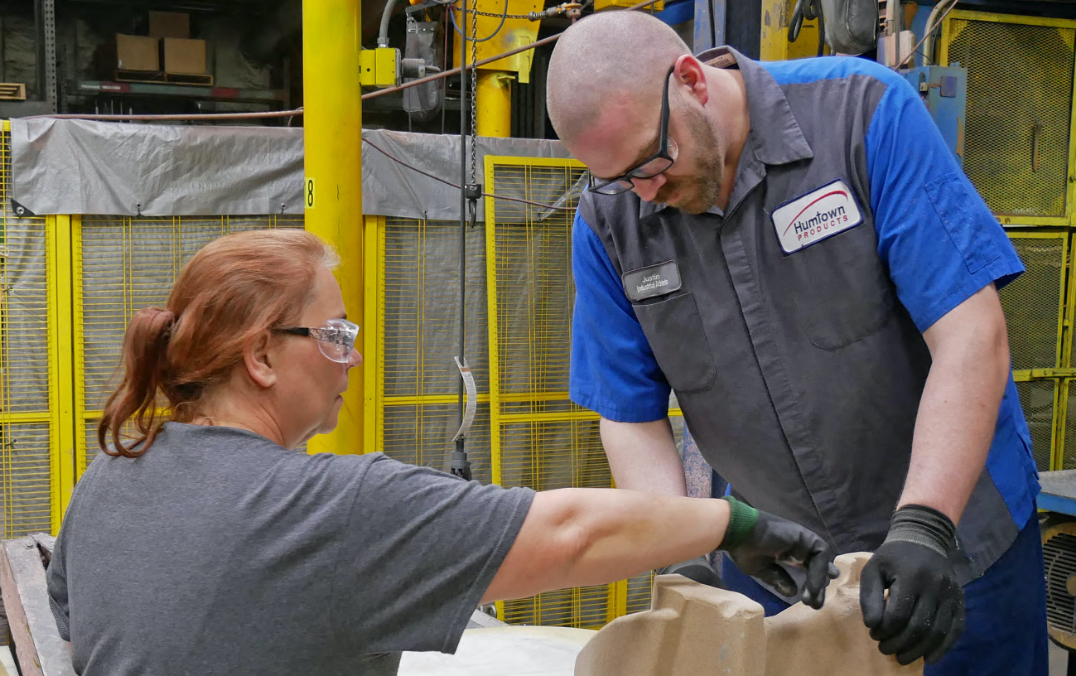Glossary of terms
This glossary contains a list of practical definitions of common foundry phrases and terms. We hope this glossary is helpful when trying to understand the world of metalcasting.
#
3D Printing
Also known as additive manufacturing (AM), 3D printing refers to various processes used to synthesize a three-dimensional object. In 3D printing, successive layers of material are formed under computer control to create an object. These objects can be of almost any shape or geometry and are produced from a 3D model or other electronic data source. A 3D printer is a type of industrial robot.
A
Acceptable Quality Level (AQL)
A quality level established on a prearranged system of inspection using samples selected at random.
Additive Manufacturing
Additive manufacturing is the official industry standard term (ASTM F2792) for all applications of 3D technology. It is defined as the process of joining materials to make objects from 3D model data, usually layer upon layer, as opposed to subtractive manufacturing methodologies.
As-Cast Condition
Casting without subsequent heat treatment.
B
Backing Sand
The bulk of the sand in the flask. The sand compacted on top of the facing sand that covers the pattern.
Binder
The bonding agent used as an additive to mold or core sand and impart strength or plasticity in a “green” or dry state.
Burn-On Sand
Sand adhering to the surface of the casting that is extremely difficult to remove.
C
Chaplet
A small metal insert or spacer used in molds to provide core support during the casting process.
Charge
A given weight of metal introduced into the furnace.
Chill
A metal insert in the sand mold used to produce local chilling and equalize rate of solidification throughout the casting.
Cleaning
Removal of runners, risers, flash, surplus metal and sand from a casting.
Cold Shut
A surface imperfection due to the unsatisfactory fusion of metal.
Cope
The top half of a horizontally parted mold.
Core
A core is a device used in casting and molding processes to produce internal cavities and reentrant angles. The core is normally a disposable item that is destroyed to get it out of the piece. They are most commonly used in sand casting, but are also used in injection molding.
Corebox
The wooden, metal or plastic tool used to produce cores.
Coreprint
A projection on a pattern that leaves an impression in the mold for supporting the core.
Core Wash
A liquid suspension of a refractory material applied to cores and dried (intended to improve surface of casting).
Coreless Induction Furnace
An electric induction furnace in which water-cooled coils that carry electrical current surround the charge material. Magnetic fields are established, and voltage is induced by a flow of electric current. The resistance of the charge metal to the current flow produces sufficient heat to melt the metal.
Crush
The displacement of sand at mold joints.
Cupola
A cylindrical, straight shaft furnace (usually lined with refractories) for melting metal in direct contact with coke by forcing air under pressure through openings near its base.
Cure
To harden.
D
Die
A metal form used as a permanent mold for die casting or for a wax pattern in investment casting.
Dowel
A pin of various types used in the parting surface of parted patterns or dies to assure correct registry.
Draft
Taper on the vertical sides of a pattern or corebox that permits the core or sand mold to be removed without distorting or tearing of the sand.
Drag
The bottom half of a horizontally parted mold.
E
Ejector Pins
Movable pins in pattern dies that help remove patterns from the die.
F
Facing Sand
The sand used to surround the pattern that produces the surface in contact with the molten metal.
Feeder
Sometimes referred to as a riser, a feeder is part of the gating system that forms the reservoir of molten metal necessary to compensate for losses due to shrinkage as the metal solidifies.
Finish Allowance
The amount of stock left on the surface of a casting for machining.
Finish Mark
A symbol (f, fl, f2, etc.) appearing on the line of a drawing that represents the edge of the surface of the casting to be machined or otherwise finished.
Flask
A rigid metal or wood frame used to hold the sand of which a mold is formed usually consisting of two parts: cope and drag.
Foundry Returns
Metal (of known composition) in the form of gates, sprues, runners, risers and scrapped castings returned to the furnace for remelting.
G
Gas Porosity
A condition existing in a casting caused by the trapping of gas in the molten metal or by mold gases that evolves during the pouring of the casting.
Gate (Ingate)
The portion of the runner where the molten metal enters the mold cavity.
Green Sand
Moist clay-bonded molding sand.
H
Heat
A single furnace charge of metal.
Heat Treatment
A combination of heating and cooling operations timed and applied to a metal or alloy in a solid state to produce desired mechanical properties.
Hotbox Process
A resin-based process that uses heated metal coreboxes to produce cores.
Hot Tear
An irregularly shaped fracture in a casting that results from stresses set up by steep thermal gradients within the casting during solidification.
I
Inclusions
Particles of slag, refractory materials, sand or deoxidation products trapped in the casting during pouring solidification.
Investment Casting
A pattern casting process in which a wax or thermoplastic pattern is used. The pattern is invested (surrounded) by a refractory slurry. After the mold is dry, the pattern is melted or burned out of the mold cavity and molten metal is poured into the resulting cavity.
L
Ladle
A container used to transfer molten metal from the furnace to the mold.
Locating Pad
A projection on a casting that helps maintain alignment of the casting for machining operations.
Locating Surface
A casting surface to be used as a basis for measurement in making secondary machining operations.
M
Master Pattern
The object from which a die can be made; generally, a metal model of the part to be cast with process shrinkage added.
Mechanical Properties
Those properties of a material that reveal the elastic and inelastic properties when force is applied. This term should not be used interchangeably with physical properties.
Metal Lot
A master heat that’s been approved for casting and given a sequential number by the foundry.
Mold
Normally consists of a top and bottom form, made of sand, metal or any other investment material. It contains the cavity into which molten metal is poured to produce a casting of definite shape.
Mold Cavity
The impression in a mold produced by the removal of a pattern. The mold cavity is filled with molten metal to form the casting.
Mold Coating
(See Core Wash.)
N
Nobake Process
Molds/cores produced with a resin-bonded air-setting sand. Also known as the air set process because molds are left to harden under normal atmospheric conditions.
P
Parting Line
The line showing the separation of the two halves of the mold.
Pattern
The wood, metal, foam or plastic shape used to form the cavity in the sand. A pattern may consist of one or many impressions and would normally be mounted on a board or plate complete with a runner system.
Pattern Draft
The taper allowed on the vertical faces of a pattern to permit easy withdrawal of the pattern from the mold or die. (See Draft.)
Pattern Layout
Full-sized drawing of a pattern showing its arrangement and structural features.
Patternmaker’s Shrinkage
The shrinkage allowance made on all patterns to compensate for the change in dimensions. Patternmaker’s shrinkage happens as the solidified casting cools in the mold. The pattern is made larger by the amount of shrinkage characteristic of the particular metal used in the casting and the amount of contraction that takes place.
Permeability
The property of a mold material to allow passage of mold/core gases during the pouring of molten metal.
Physical Properties
Properties of matter such as density, electrical and thermal conductivity, expansion and specific heat. This term should not be used interchangeably with mechanical properties.
Pig Iron
Blocks of iron that are used for melting (with suitable additions of scrap, etc.) for the production of ferrous castings.
Pilot Casting
Also known as sample casting, pilot casting is a casting made from a pattern produced in a production die to check the accuracy of dimensions and quality of castings that will be made.
Porosity
Holes in the casting. Possible reasons for porosity include gases trapped in the mold, the reaction of molten metal with moisture in the molding sand or the imperfect fusion of chaplets with molten metal.
R
Recovery Rate
The ratio of the number of saleable parts divided by the total number of parts manufactured, expressed as a percentage.
Refractory Heat
Resistant ceramic material.
Reject Rate
The ratio of the number of parts scrapped divided by the total number of parts manufactured, expressed as a percentage.
Riser
(See Feeder.)
Runner System
Also known as a gating system, a runner system is the set of channels in a mold through which molten metal is poured to fill the mold cavity. The system normally consists of a vertical section (downgate or sprue), a mold cavity (gate) and other vertical channels (risers or feeders).
S
Sand Inclusions
Cavities or surface imperfections on a casting caused by sand washing into the mold cavity.
Scrap
(a) Any scrap metal melted (usually with suitable additions of pig iron or ingots) used to produce castings; (b) reject castings.
Shakeout
The process of separating the solidified casting from the mold material.
Shrinkage
Contraction of metal in the mold during solidification. The term also is used to describe a casting defect, such as shrinkage cavity, which results from poor design, insufficient metal feed or inadequate feeding.
Slag
A fused nonmetallic material that protects molten metal from the air and extracts certain impurities from the melt.
Slag Inclusions
Surface imperfections of a casting similar to sand inclusions, but containing impurities from the charge materials, silica and clay that erodes from refractory lining and ash from the fuel during the melting process. Slag inclusions may also originate from metal-refractory reactions that occur in the ladle during the pouring of a casting.
Slurry
A flowable mixture of refractory particles suspended in a liquid.
Sodium Silicate/CO2 Process
When molding sand is mixed with sodium silicate and the mold is gassed with CO2 gas to produce a hard mold or core.
Sprue
Also known as a downsprue or downgate, a sprue is the channel (usually vertical) that the molten metal enters.
T
Test Bar
A standard specimen bar designed to determine the mechanical properties of the metal from which it was poured.
Test Lug
A lug cast that’s part of the casting and later removed for testing purposes.
V
Vent
An opening or passage in a mold or core that facilitates the escape of gases when the mold is poured.

CONVENTIONAL Sand Cores & Molds
In addition to 3D printed cores and molds, we are also global leaders in conventional manufacturing. Humtown Products, a division of Humtown that specializes in the more traditional cold-box and air-set processes, produces cores and molds in Columbiana, Ohio. Serving the foundry industry for more than 50 years, they know a thing or two about optimizing their cores and molds for the casting process.
